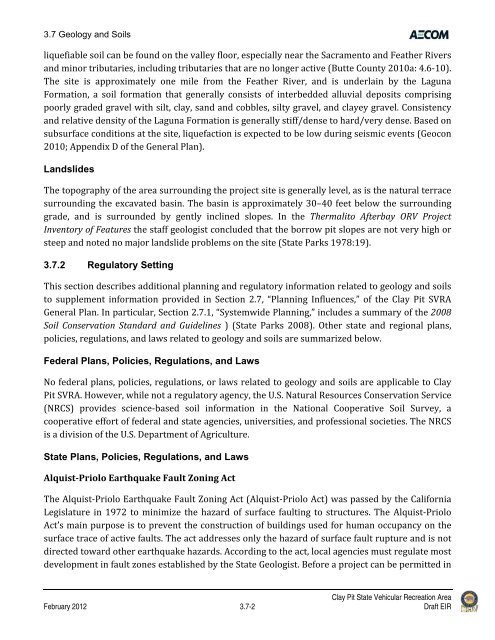Draft Environmental Impact Report - California Off Highway Vehicle ...
Draft Environmental Impact Report - California Off Highway Vehicle ...
Draft Environmental Impact Report - California Off Highway Vehicle ...
Create successful ePaper yourself
Turn your PDF publications into a flip-book with our unique Google optimized e-Paper software.
3.7 Geology and Soils<br />
liquefiable soil can be found on the valley floor, especially near the Sacramento and Feather Rivers<br />
and minor tributaries, including tributaries that are no longer active (Butte County 2010a: 4.6‐10).<br />
The site is approximately one mile from the Feather River, and is underlain by the Laguna<br />
Formation, a soil formation that generally consists of interbedded alluvial deposits comprising<br />
poorly graded gravel with silt, clay, sand and cobbles, silty gravel, and clayey gravel. Consistency<br />
and relative density of the Laguna Formation is generally stiff/dense to hard/very dense. Based on<br />
subsurface conditions at the site, liquefaction is expected to be low during seismic events (Geocon<br />
2010; Appendix D of the General Plan).<br />
Landslides<br />
The topography of the area surrounding the project site is generally level, as is the natural terrace<br />
surrounding the excavated basin. The basin is approximately 30–40 feet below the surrounding<br />
grade, and is surrounded by gently inclined slopes. In the Thermalito Afterbay ORV Project<br />
Inventory of Features the staff geologist concluded that the borrow pit slopes are not very high or<br />
steep and noted no major landslide problems on the site (State Parks 1978:19).<br />
3.7.2 Regulatory Setting<br />
This section describes additional planning and regulatory information related to geology and soils<br />
to supplement information provided in Section 2.7, “Planning Influences,” of the Clay Pit SVRA<br />
General Plan. In particular, Section 2.7.1, “Systemwide Planning,” includes a summary of the 2008<br />
Soil Conservation Standard and Guidelines ) (State Parks 2008). Other state and regional plans,<br />
policies, regulations, and laws related to geology and soils are summarized below.<br />
Federal Plans, Policies, Regulations, and Laws<br />
No federal plans, policies, regulations, or laws related to geology and soils are applicable to Clay<br />
Pit SVRA. However, while not a regulatory agency, the U.S. Natural Resources Conservation Service<br />
(NRCS) provides science‐based soil information in the National Cooperative Soil Survey, a<br />
cooperative effort of federal and state agencies, universities, and professional societies. The NRCS<br />
is a division of the U.S. Department of Agriculture.<br />
State Plans, Policies, Regulations, and Laws<br />
AlquistPriolo Earthquake Fault Zoning Act<br />
The Alquist‐Priolo Earthquake Fault Zoning Act (Alquist‐Priolo Act) was passed by the <strong>California</strong><br />
Legislature in 1972 to minimize the hazard of surface faulting to structures. The Alquist‐Priolo<br />
Act’s main purpose is to prevent the construction of buildings used for human occupancy on the<br />
surface trace of active faults. The act addresses only the hazard of surface fault rupture and is not<br />
directed toward other earthquake hazards. According to the act, local agencies must regulate most<br />
development in fault zones established by the State Geologist. Before a project can be permitted in<br />
Clay Pit State Vehicular Recreation Area<br />
February 2012 3.7-2 <strong>Draft</strong> EIR








